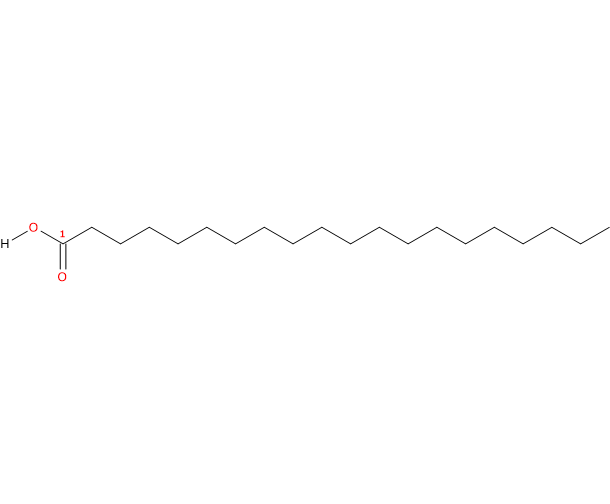Arachidic acid (20 carbon atoms) was first discovered by Gössmann A. in 1854 in peanuts oil; peanuts are the seed of Arachis hypogea from which its name.
It belongs to the group of saturated fatty acids (no double bond, so its shorthand notation is 20:0), and is also a member of the group called very long chain fatty acids (VLCFA), from 20 carbon atoms onwards.
PROPERTIES
Molecular weight: 312.5304 g/mol
Molecular formula: C20H40O2
IUPAC name: icosanoic acid
CAS registry number: 506-30-9
PubChem: 10467

In purified form it is a white crystalline solid practically insoluble in water, with melting point at 75.5 °C (167.9 °F; 348.65 K) and boiling point (with some decomposition) at 328 °C (622.4 °F; 601.15 K) at 760 mmHg.
OTHER NAMES
arachic acid
eicosanoic acid
n-eicosanoic acid
20:0
Food sources of arachidic acid
It is found in appreciable quantities only in some vegetable fats and oils, where it occurs as glycerol ester.
It is virtually absent from fresh red and white meat, and in almost all processed and preserved meats, lard and suet included. The exception is certain types of salami where, however, it is found in very small amounts, never exceeding 0.35 g/100 g of edible portion.
It is not found in dairy products, including butter.
In eggs, it is only present in small quantities in whole egg powder (in chicken whole egg powder, 0.58 g/100 g of edible portion).
It is virtually absent from fishery products (fish, mollusks and crustaceans); the amount, if present, does not exceed 0.01 g / 100 g of edible portion.
It is present, although not high quantity, in vegetable fats and oils:
- peanut oil contains the highest quantity, about 2.3 g/100 g of edible portion;
- it is found in small quantities in peanut butter, 0.72 g/100 g of edible portion, while it is absent in margarine.
In cereals and derivatives, it is found in trace amounts, never higher than 0.1 g/100 g of edible portion.
In fresh and dried oily fruits, it is present in small quantities, with a maximum value in dried coconut, 0.6 g/100 g of edible portion.
It is absent in legumes, with the exception of soybean meal, where it is found in trace amounts, 0.07 g/100 g of edible portion.
References
- Akoh C.C. and Min D.B. “Food lipids: chemistry, nutrition, and biotechnology” 3th ed. 2008
- Chow Ching K. “Fatty acids in foods and their health implication” 3th ed. 2008